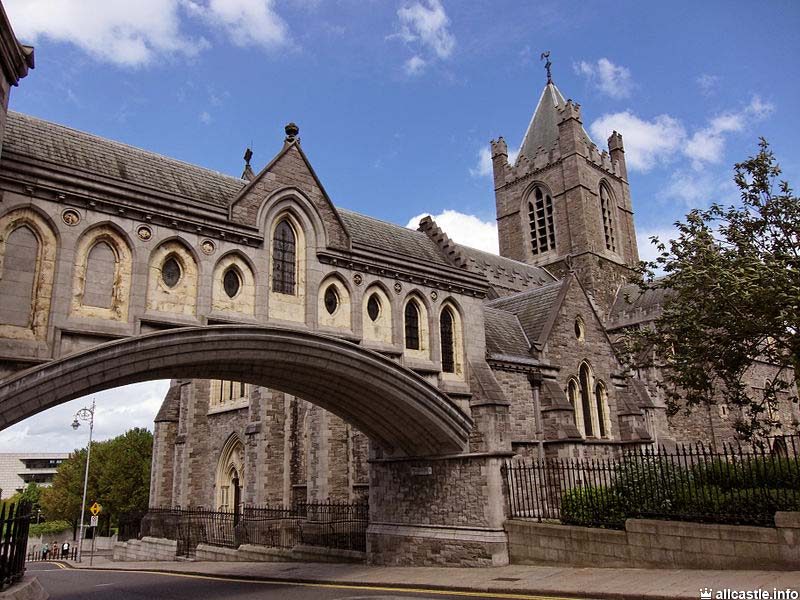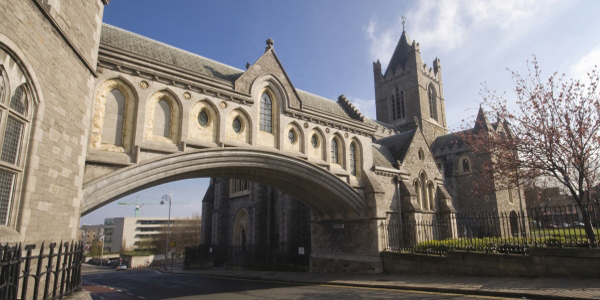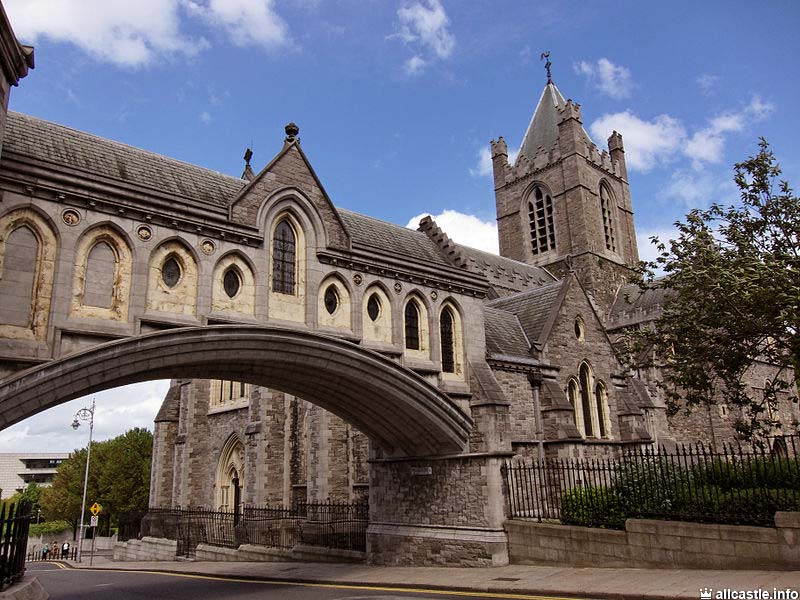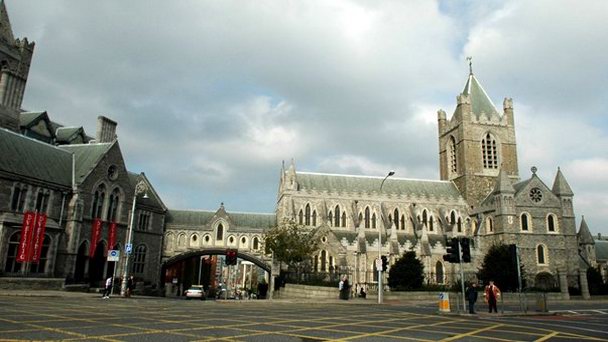Christ Church Cathedral (or, more formally, The Cathedral of the Holy Trinity) is the cathedral of the United Dioceses of Dublin and Glendalough and the cathedral of the Ecclesiastical province of the United Provinces of Dublin and Cashel in the Church of Ireland. It is situated in Dublin, Ireland, and is the elder of the capital city's two medieval cathedrals, the other being St Patrick's Cathedral.
Christ Church is officially claimed as the seat (cathedra) of both the Church of Ireland and Roman Catholic archbishops of Dublin. In law, and in fact it has been the cathedral of only the Church of Ireland's Archbishop of Dublin, since the English Reformation. Though nominally claimed as his cathedral, the Roman Catholic Archbishop of Dublin uses St Mary's in Marlborough Street in Dublin as his pro-cathedral (acting cathedral).[nb 1]
Christ Church Cathedral is located in the former heart of medieval Dublin, next to Wood Quay at the end of Lord Edward Street. However a major dual carriage-way building scheme around it separated it from the original medieval street pattern which once surrounded it, with its original architectural context (at the centre of a maze of small buildings and streets) lost due to road-building and the demolition of the older residential quarter at Wood Quay. As a result the cathedral now appears dominant in isolation behind new civil offices along the quays, out of its original medieval context.
Christ Church is the only one of the three cathedrals or acting cathedrals which can be seen clearly from the River Liffey.
The cathedral was founded probably sometime after 1028 when King Sitric Silkenbeard, the Hiberno-Norse king of Dublin made a pilgrimage to Rome. The first bishop of this new Dublin diocese was Dúnán or Donat, and the diocese was at that time a small island of land surrounded by the much larger Diocese of Glendalough, and was for a time answerable to Canterbury rather than to the Irish Church hierarchy. The church was built on the high ground overlooking the Viking settlement at Wood Quay and Sitric gave the "lands of Baldoyle, Raheny and Portrane for its maintenance." Of the four old Celtic Christian churches reputed to have existed around Dublin, only one, dedicated to St. Martin of Tours, lay within the walls of the Viking city, and so Christ Church was one of just two churches for the whole city.
The cathedral was originally staffed by secular clergy. The second Bishop of Dublin introduced the Benedictines. In 1163, Christ Church was converted to a priory of the Regular Order of Arrosian Canons (Reformed Augustinian Rule) by the second Archbishop of Dublin, later saint, Laurence O'Toole, who adhered to the rule himself; it was subsequently headed by an Augustinian prior, who ranked as the second ecclesiastical figure of the diocese, and not a dean, until re-establishment in 1541. This priory, the Priory of the Holy Trinity, became the wealthiest religious house in Ireland, holding over 10,000 acres (40 km2) of property in County Dublin alone, most notable of which were the three home farms held at Grangegorman, Glasnevin and Clonken or Clonkene, now known as Deansgrange.
Henry II attended the Christmas service at the cathedral in 1171. According to the cathedral guidebook this was the first time Henry received Holy Communion following the murder of Thomas Beckett by Henry's knights in Canterbury.
In the 1180s, Strongbow and other Norman magnates helped to fund a complete rebuilding of Christ Church, initially a wooden building, in stone, comprising the construction of a choir, choir aisles and transepts, the crypt and chapels to St. Edmund and St. Mary and St. Lô.
A chapel to St Laurence O'Toole was added in the 13th century and much of the extant nave was built in the 1230s. Its design was inspired by the architecture of the English western school of Gothic, and its wrought stones- of a Somersetshire oolite- were sculpted and laid by craftsmen from the same area.
In 1300 Richard de Ferings, Archbishop of Dublin arranged an agreement between the two cathedrals, the Pacis Compostio, which acknowledged both as cathedrals and made some provision to accommodate their shared status (see below for more on this).
In the 1350s a major extension was undertaken by John de St Paul, Archbishop of Dublin 1349-62. By 1358, the nave of the cathedral was partly in use for secular purposes and a "long quire" was added, extending the old choir area by around 10 metres. St Paul also installed an organ. His works were destroyed by the major rebuilding project in the 1870s.
In 1480 the wealthy judge William Sutton bequeathed all his lands and silver to the Cathedral.
The cathedral was the location of the purported coronation, in 1487, of Lambert Simnel, a boy pretender who sought unsuccessfully to depose Henry VII of England, as "King Edward VI".
In 1539, King Henry VIII converted the priory to a cathedral with a dean and chapter and worked to ensure Christ Church adhered to his new church structure. His immediate successor, Edward VI of England, in 1547, provided funds for an increase in cathedral staffing and annual royal funding for the choir school.
King Edward VI formally suppressed St Patrick's Cathedral and, on 25 April 1547, its silver, jewels and ornaments were transferred to the dean and chapter of Christ Church. This episode ended with a late document of Queen Mary's reign, a deed dated 27 April 1558, comprising a release or receipt by Thomas Leverous, dean, and the chapter of St Patrick's, of the "goods, chattels, musical instruments, etc." belonging to that cathedral and which had been in the possession of the dean and chapter of Christ Church.
Queen Mary I of England, and later James I of England, also increased Christ Church's endowment. Meanwhile, in 1551, divine service was sung for the first time in Ireland in English instead of Latin. In 1560, the Bible was first read in English.
The foundations of the nave, resting in peat, slipped in 1562, bringing down the south wall and the arched stone roof (the north wall, which visibly leans, survived, and largely dates back to 1230). Partial repairs were carried out but much of the debris was simply levelled and new flooring built over it until 1871. In 1620 the English-born judge Luke Gernon observed that Christchurch was in a better state of repair than St. Patrick's.
In the 17th century, both parliament and the law courts met in buildings erected alongside Christ Church. King James II himself presided over a state opening of parliament in that location. However, parliament and the law courts both moved elsewhere: the law courts to the newly built Four Courts on the river front, and Parliament to Chichester House in Hoggen Green, into the building which is now The Bank of Ireland, College Green.
Like nearby St Patrick's, the building was in poor condition for much of the 19th century. After the building was declared unsafe and no longer fit for use, some limited works were carried out by Matthew Price (architect) between 1829 and 1831.













